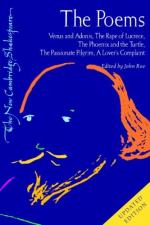|
This section contains 11,483 words (approx. 39 pages at 300 words per page) |

|
SOURCE: Klause, John. “The Phoenix and Turtle in Its Time.” In In the Company of Shakespeare: Essays on English Renaissance Literature in Honor of G. Blakemore Evans, edited by Thomas Moisan and Douglas Bruster, pp. 206-30. Cranbury, N.J.: Associated University Presses, 2002.
In the following essay, Klause places The Phoenix and Turtle within its appropriate cultural, literary, autobiographical, religious, and ideological contexts in order to ascertain its proper significance in Shakespeare's oeuvre. The critic concludes that rather than celebrating Sir John Salusbury, as the other contributors to Love's Martyr had done, Shakespeare set out to subtly disparage him.
“There is no Excellent Beauty,” declared Bacon, “that hath not some Strangeness in the Proportion.” Strange and beautiful, beautiful in its strangeness, is Shakespeare's The Phoenix and Turtle—at least so it must seem to the eye that does not find (as some have found) its brilliance “frigid and perfunctory...
|
This section contains 11,483 words (approx. 39 pages at 300 words per page) |

|


